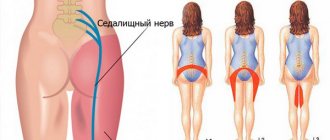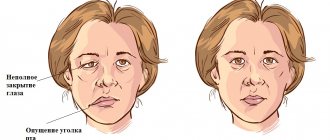Causes of inflammatory damage to the trigeminal nerve
Factors contributing to inflammation of the trigeminal nerve are:
- surgical interventions on the jaw bones;
- fractures of the base of the skull, lower and upper jaws;
- tumors;
- complex tooth extraction;
- hypothermia;
- surgery on the maxillary sinus;
- improperly administered anesthesia;
- incorrectly performed dental prosthetics;
- metabolic disorders;
- the presence of foreign bodies that irritate the nerve trunk or injure nerve endings;
- bacterial or viral infection;
- various types of intoxication of the body;
- hypovitaminosis;
- weakening of the immune system.
Trigeminal nerve - what is it?
The trigeminal nerve is located on both sides of the face and is one of the cranial nerves, being one of the largest and most important in terms of functionality. It is responsible for the sensitivity of the skin of the face, teeth, oral mucosa and some other areas of the head, and also partly regulates the process of salivation.
Many people often confuse the trigeminal and facial nerves or even believe that they are one and the same thing. The Internet is full of materials that talk about inflammation of the trigeminal facial nerve or describe the symptoms of inflammation of the trigeminal facial nerve. These formulations are incorrect and mislead people, since these are two different pairs of nerves with their own structural features and functional purpose. The facial nerve is also one of the cranial nerves: it runs quite close to the surface of the face and is also responsible for the work of facial muscles. Neuritis can also affect the facial nerve, but the disease will progress differently.
It is also incorrect to talk about inflammation of the trigeminal nerve of the tooth, since there is no trigeminal nerve in the teeth, but its processes are in close proximity to them.
Symptoms of trigeminal neuritis
The maxillary trigeminal nerve consists of three types of nerve fibers:
- vegetative;
- motor;
- sensitive.
The symptomatic picture of neuritis may vary depending on which fibers were affected by the inflammatory process.
Damage to sensory fibers
In particular, with inflammation of the sensory fibers, the patient may complain of a tingling sensation, numbness, and weakened sensitivity in the area innervated by the trigeminal nerve.
Damage to motor fibers
When motor fibers are damaged, there is a partial or complete decrease in strength in the innervated muscles, their atrophy and deterioration of tendon reflexes.
Damage to vegetative fibers
When the vegetative fibers are inflamed, the patient experiences cyanosis and swelling of the skin, dryness and thinning of the skin, and the potential risk of developing a trophic ulcer increases.
Causes of trigeminal neuralgia
Symptoms of facial neuralgia occur due to compression of the trigeminal nerve root by the cerebellar artery at its entrance to the brain stem. Destruction of the nerve fiber sheath occurs due to the fact that the artery either compresses the nerve or wraps around it. This pathology occurs due to inflammatory processes in the nasal mucosa, periodontal tissue or other organs, which lead to a narrowing of the lumen of the canal through which the nerve passes.
In addition, trigeminal neuralgia can develop due to:
- hypothermia of nerve fibers with subsequent spasms of facial muscles;
- disruptions in the functioning of the endocrine system;
- compression due to growth of tumors;
- pathologies of neurogenic and vascular nature;
- herpes virus.
At CELT you can get advice from a specialist algologist.
Make an appointment
Pain due to inflammation
In addition, a disease such as inflammation or neuritis of the facial trigeminal nerve makes itself felt with attacks of pain of a very diverse nature:
- cutting,
- burning,
- pricking,
- tearing
- shooting, etc.
In this case, the area of pain does not always correspond to the area of innervation and can spread to the lower jaw, cheeks and chin.
Pain may be accompanied by:
- muscle spasms (facial, chewing),
- the appearance of nasal discharge,
- development of hypersalivation,
- increased lacrimation.
Lack of sensation in the tongue, lips and chin
With inflammatory damage to the trigeminal nerve, not only the entire nerve can be damaged, but also its individual branches. This is why numbness and pain can occur in various areas of the face. For example, when the lingual branch of the nerve is inflamed, patients complain of pain and sensitivity disturbances in the anterior part of the tongue, and when the mental branch is damaged, in the area of the lips and chin.
Pain when laughing, chewing, brushing teeth and shaving
Pain due to neuritis of the maxillary trigeminal nerve can intensify with touching, chewing, laughing and with changes in temperature. That is why patients, trying to prevent the recurrence of painful attacks, avoid excessive mobility and prolonged conversations, and refuse brushing their teeth and shaving.
Symptoms of neuritis, neuropathy, inflammation of the facial nerve
The essence of the symptoms is the disconnection from the brain of those areas whose function is controlled by the facial nerve:
- Weakness or paralysis of the facial muscles of one half of the face, which is expressed in the inability to raise the eyebrows, close the eyes, blink, wrinkle the nose, smile, puff out the cheeks (sail symptom); sometimes you feel the chin being pulled down, tension in the subcutaneous muscle of the neck;
- As a result of the disconnection of the facial muscles, a drooping of the corner of the mouth and smoothness of the nasolabial fold may be noticeable;
- As a result of the shutdown of the cheek muscles, it may be difficult to eat liquid foods;
- Sometimes the symptoms described above are accompanied by dry eyes or lacrimation, increased sensitivity to sounds (booming in the ear), decreased taste sensitivity, increased or decreased sensitivity of the facial skin on the affected side.
Treatment of neuritis of the maxillary trigeminal nerve
Therapy
The treatment program for trigeminal neuritis is drawn up taking into account the causes of the disease and its clinical signs. The main goals of treatment are:
- achieving a sensitizing effect;
- fight against bacterial and viral infection;
- increasing the body's immune forces;
- elimination of swelling of the nerve trunk;
- restoration of natural adaptive and compensatory reactions;
- normalization of the patency of nerve impulses.
Healing procedures
The set of procedures aimed at blocking the inflammatory process and eliminating all manifestations of neuritis includes:
- antibacterial therapy;
- antiviral therapy;
- elimination of factors contributing to the occurrence of intoxication;
- removal of tumor-like neoplasms or dissection of adhesions compressing the nerve;
- prescribing vitamin and mineral complexes to the patient;
- stimulation of nerves and muscles;
- acupuncture;
- physiotherapy (electrophoresis, phonophoresis, UHF, ultrasound, paraffin therapy).
People suffering from trigeminal neuritis are advised to regularly visit dental clinics and have their oral cavity sanitized.
Causes and symptoms of facial neuritis
The facial nerve is a long nerve fiber, which, located on both sides of the face, regulates the functioning of all facial muscles. Some of its branches are responsible for the sensation of taste, as well as for the secretion of saliva and tears. When the large branches of this nerve fiber become inflamed, it is called facial neuritis. This is usually a one-way process.
The causes of facial neuritis are mainly infectious: it is caused by viruses or bacteria that have entered the body. The manifestations of the disease are very specific, so diagnosis is not a problem. Treatment of neuritis of the facial nerve is carried out by a neurologist.
Facial neuritis occurs due to:
- hypothermia of the face;
- herpetic infection;
- polio virus;
- mumps virus;
- inflammation of ear structures close to the nerve as a result of a bacterial infection or infection with ARVI viruses;
- nerve injury;
- disruption of nutrition of the central parts of the nerve (it leaves directly from the brain) as a result of stroke, encephalitis.
The first symptoms of facial neuritis are pain and discomfort in the postauricular area. After 1-2 days the following develop:
- weakness of the muscles of half the face (facial expressions become “poor”);
- facial asymmetry: “crooked smile”, drooping one corner of the mouth;
- asymmetry of the lips when baring or smiling;
- inability to close the eye, and a white portion of the sclera is always visible between the iris and the eyelid;
- inability to stretch out the lips, puff out the cheeks (one cheek sags and air escapes), raise one eyebrow;
- disturbance of the sense of taste on the front part of the tongue;
- lacrimation from one eye: it can be present constantly, or appear only during meals, and the rest of the time the eye will dry out from lack of tears.
A herpetic lesion is characterized by the addition of severe pain in the ear to the above symptoms, which will “shoot” in the back of the head and face, ringing in the ears, dizziness, and involuntary movements of the eyeballs. Herpes-specific “bubbles” can be detected not from the first day of the disease on the auricle, on the mucous membrane of the pharynx and tongue.
With parotitis, the main symptoms of facial neuritis appear against the background of weakness, increased temperature, and the appearance of swelling behind and under the ear (while the skin color does not change).
What symptoms facial neuritis will have will depend on where the lesion is located: in the central part, or one of the peripheral branches is inflamed. So, if the nerve is inflamed at the point where it exits the trunk, then hearing impairment is added to the symptoms described above. If the lesion is in the brain stem, then convergent strabismus will be added to the main signs of neuritis. Based on the symptoms, the neurologist understands where the pathological process is located and prescribes appropriate diagnosis and treatment.
Facial nerve neurosis
Neurosis of the facial nerve is sometimes confused with neuritis, although it has nothing to do with inflammation. Tibetan medicine classifies it as a disease of the Wind system and considers its main cause to be nervous, emotional stress, psycho-emotional disorders, and mental fatigue. Often this disease accompanies depression, anxiety and fear neuroses.
Symptoms of facial neurosis are spasms of facial muscles, nervous tics in the form of blinking, twitching of the face, obsessive, involuntary swallowing. Sometimes nervous tics are accompanied by a feeling of numbness, tingling or burning.
Muscle twitching can start from the cheek, then move to the eye area, the orbicularis muscle. This causes symptoms of blepharospasm - frequent blinking, photophobia, dry eyes. When severe, blepharospasm can result in the inability to see out of one eye.
What to do if the facial nerve on the cheek twitches? Symptomatic treatment of facial neurosis consists of the use of antispasmodics, sedatives, and anticonvulsants. In Eastern medicine, these drugs are not used because they do not affect the cause of the disorder. Instead, the Tibet Clinic uses complex herbal medicine.
Herbal medicines of Tibetan medicine have an equally effective sedative, calming effect and at the same time help:
- restore the overall balance of the nervous system,
- improve and stabilize emotional state,
- restore psycho-emotional stability,
- eliminate symptoms of stress, mental overload, fatigue,
- increase the stability of the nervous system under stress.
These herbal remedies are used in the complex treatment of anxiety neuroses, fear, depressive and other disorders of the nervous system. They complement well acupuncture, acupressure, moxotherapy, relaxation massage, stone therapy and other methods of oriental medicine. With their help, doctors at our clinic effectively eliminate the symptoms and causes of facial neurosis and restore normal tone of facial muscles.











